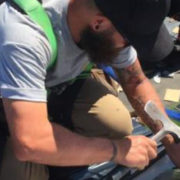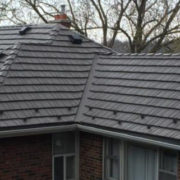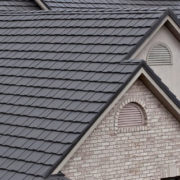Last updated on May 13th, 2017 at 01:29 am
We get it, buckling down to read a metal roofing warranty is probably the last thing you want to do at the end of a busy day. But if you are seriously considering investing in a permanent roofing product, doing your homework could end up saving you tens of thousands of dollars and a whole lot of headaches and disappointment.
Metal Roofing Warranties Explained
Chances are you will be considering a few products for your metal roof upgrade. To help you through the process we’ve collected some of the most commonly overlooked or misleading terms so you can easily navigate your way to a product that meets all of your requirements. In theory, performance and warranty length should be synonymous but please don’t be fooled by the shiny graphics boasting 40, 50 or Lifetime warranties. The latter are marketing tools and can easily be voided by pro-ration and loopholes contained in the fine print.
Pro-Rated or Non Pro-Rated?
The first thing to find out about the warranty for any product you are considering is whether or not it is pro-rated. Pro-ration of a warranty means that over time coverage value declines. Manufacturers usually know when their products will fail and pro-rate accordingly. In some cases we have seen metal roofing warranties that mention pro-ration but do not define the pro-ration rate, leaving it up to them to decide how much your warranty is worth at any given time.
How to Read a Metal Roof Warranty
Assuming you want a product that will be permanent, having a basic understanding of the 3 key components of a lifetime roof is a great place to start.
- Base Metal or Substrate: The first major difference between metal roof systems is what substrate is used. The three most common being steel, aluminum and copper.
- The Coating or Paint: Understand your colour coating choices. Even if you don’t mind a little peeling or fading, chances are you’ll be very disappointed if your permanent roof is covered in rust because the coating was inferior.
- Panel Design: Panel design also dictates the installation method.
Pay special attention to paragraphs relating to the 3 key components above. A warranty that has many paragraphs (too many) related to any one of the key components should be looked at very closely. Difficult to understand wording or “legalese” found in those paragraphs are a big sign to proceed with caution. Read on for specific examples of what to look for.
Commonly Used Terms that Limit or Void Coverage
Weak Warranty Term #1: “Company warrants the product to be free from defects in material that could result in rusting, cracking, curling etc.”
What it means: Covering against manufacturing defects only makes manufacturer responsible for something that went wrong within their manufacturing process. If the issue cannot be traced to their manufacturing process (a homeowner’s responsibility to prove) the manufacturer is not responsible.
What to look for in a strong warranty: Coverage against rusting, cracking, curling etc. of the product under any normal circumstances at any stage of lifecycle.
Weak Warranty Term #2: “Company warrants against splitting, cracking or perforation from hailstones of a specific diameter.”
What it means: Coverage is limited to the panel itself. However, the most vulnerable area of a roof in a hail storm are the overlaps or interlocks between the panels.
What to look for in a strong warranty: coverage against any leaking due to hail of any size.
Weak Warranty Term #3: “Corrosion on the reverse side of panel due to insufficient insulation or ventilation is not covered.”
What it Means: Even if the panels do rust to the point of perforation or structural failure, this clause gives them the right to determine the rust began on the backside of the panel due to condensation thus voiding coverage.
What to look for in a strong warranty: coverage that is not voided by corrosion starting on the backside of a roofing panel.
Weak Warranty Term #4: “For a period of X# years the paint shall not exhibit cracking, peeling flaking etc.”
What it Means: If the paint used on the substrate has a designated shorter life on the warranty, then you know that you are not getting the best quality paint or coating. It may not be the cause of leaks but most homeowners would agree that a flaky or rusty roof would be an eyesore and decrease home value.
What to look for in a strong warranty: coverage that does not separate paint or coating life from panel life. Note: in the case of fading or chalking it would be impossible to guarantee absolute zero for a lifetime. Look for products that guarantee fade not to exceed 5 Hunter E Units (how fade is measured) in a period of 25 years or more. Chalking should not exceed ASTM D-659-80 rating (how chalk is measured) of 8 over 25 years or more.
Weak Warranty Term #5: “Warranty only applies to product installed on a minimum 4:12 Pitch (or higher).”
What it Means: If you have a low pitched roof you may not receive any coverage at all. A well designed panel should have a recommended minimum pitch of 3:12. In the case of a standing seam style product 2:12 or lower should be the minimum (depending on lock design). If a warranty only covers 4:12 or higher, this implies a less water tight system.
What to look for in a strong warranty: for metal shingle style products 3:12 should be the minimum pitch and for standing seam a 2:12 minimum is good.
Weak Warranty Term #6: “If it is determined by the Manufacturer, upon inspection that a claim for defective panels is valid – defective or non conforming panels will be replaced.”
What it Means: If the manufacturer agrees that the panels in question are defective they will replace only those panels but will not cover the labour costs involved in rectifying the problem.
What to look for in a strong warranty: Look for a warranty that will cover replacement and labour costs for awarded claims.
A Note About Warranty Transfers
Many companies advertise transferable warranties. Please be sure to ask about: associated fees and paperwork, number of allowable transfers, number of years that the warranty is transferable and how many years after installation will the transfer cover? If you do decide to sell your home, a roof with a long-life warranty is a great selling feature that has proven to increase home value.
A Note About Coastal Situations
Please be aware that if you live on or near the water, you need to ask the manufacturer if you will be covered. Most steel products will not be covered due to accelerated corrosion rate caused by the salt spray air.
In Summary
This article could not cover every possible scenario, but can help you pinpoint some of the biggest concerns. There really is no way around doing your homework to protect yourself and your hard earned dollars.
Taking the time to search for a great product, manufacturer and installation will ultimately result in great peace of mind that you have chosen a true lifetime and maintenance-free roof!
Have a warranty that you would like analysed? Send it to:








Excellent article
Thank you.
Great article. Great breakdown on metal roofing warranties. I can say with almost 100% certainty that people don’t read these or don’t know how to interpret them. This is a very helpful breakdown. Thanks for sharing.